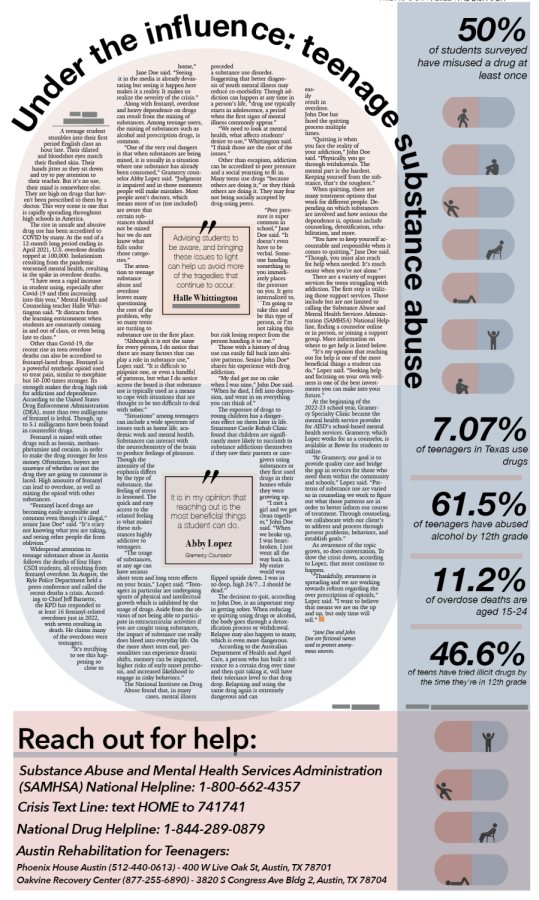Under the influence: teenage substance abuse
The attention to teenage substance abuse and overdose leaves many questioning the root of the problem, why so many teens are turning to substance use in the first place.
October 27, 2022
A teenage student stumbles into their first period English class an hour late. Their dilated and bloodshot eyes match their flushed skin. Their hands jitter as they sit down and try to pay attention to their teacher. But it’s no use, their mind is somewhere else. They are high on drugs that haven’t been prescribed to them by a doctor. This very scene is one that is rapidly spreading throughout high schools in America.
The rise in unsafe and abusive drug use has been accredited to COVID by many. At the end of a 12-month long period ending in April 2021, U.S. overdose deaths topped at 100,000. Isolationism resulting from the pandemic worsened mental health, resulting in the spike in overdose deaths.
“I have seen a rapid increase in student using, especially after Covid-19 and then increasing into this year,” Mental Health and Counseling teacher Halle Whittington said. “It distracts from the learning environment when students are constantly coming in and out of class, or even being late to class.”
Other than Covid-19, the recent rise in teen overdose deaths can also be accredited to fentanyl-laced drugs. Fentanyl is a powerful synthetic opioid used to treat pain, similar to morphine but 50-100 times stronger. Its strength makes the drug high risk for addiction and dependence. According to the United States Drug Enforcement Administration (DEA), more than two milligrams of fentanyl is lethal. Though, up to 5.1 milligrams have been found in counterfeit drugs.
Fentanyl is mixed with other drugs such as heroin, methamphetamine and cocaine, in order to make the drug stronger for less money. Oftentimes, buyers are unaware of whether or not the drug they are going to consume is laced. High amounts of fentanyl can lead to overdose, as well as mixing the opioid with other substances.
“Fentanyl laced drugs are becoming easily accessible and common even though it’s illegal,” senior Jane Doe* said. “It’s scary not knowing what you are taking, and seeing other people die from oblivion.”
Widespread attention to teenage substance abuse in Austin follows the deaths of four Hays CSDI students, all resulting from fentanyl overdose. In August, the Kyle Police Department held a press conference and called the recent deaths a crisis. According to Chief Jeff Barnette, the KPD has responded to at least 16 fentanyl-related overdoses just in 2022, with seven resulting in death. He claims many of the overdoses were teenagers.
“It’s terrifying to see this happening so close to home,” Jane Doe said. “Seeing it in the media is already devastating but seeing it happen here makes it a reality. It makes us realize the severity of the crisis.”
Along with fentanyl, overdose and heavy dependence on drugs can result from the mixing of substances. Among teenage users, the mixing of substances such as alcohol and prescription drugs, is common.
“One of the very real dangers is that when substances are being mixed, it is usually in a situation where one substance has already been consumed,” Gramercy counselor Abby Lopez said. “Judgment is impaired and in those moments people will make mistakes. Most people aren’t doctors, which means most of us (me included) are aware that certain substances should not be mixed but we do not know what falls under those categories.”
The attention to teenage substance abuse and overdose leaves many questioning the root of the problem, why so many teens are turning to substance use in the first place.
“Although it is not the same for every person, I do notice that there are many factors that can play a role in substance use,” Lopez said. “It is difficult to pinpoint one, or even a handful of patterns, but what I do notice across the board is that substance use is typically used as a means to cope with situations that are thought to be too difficult to deal with sober.”
“Situations” among teenagers can include a wide spectrum of issues such as home life, academic work and mental health. Substances can interact with the neurochemistry of the brain to produce feelings of pleasure. Though the intensity of the euphoria differs by the type of substance, the feeling of stress is lessened. The quick and easy access to the relaxed feeling is what makes these substances highly addictive to teenagers.
“The usage of substances, at any age can have serious short term and long term effects on your brain,” Lopez said. “Teenagers in particular are undergoing spurts of physical and intellectual growth which is inhibited by the usage of drugs. Aside from the obvious of not being able to participate in extracurricular activities if you are caught using substances, the impact of substance use really does bleed into everyday life. On the more short term end, personalities can experience drastic shifts, memory can be impacted, higher risks of early onset psychosis, and increased likelihood to engage in risky behaviors.”
The National Institute on Drug Abuse found that, in many cases, mental illness preceded a substance use disorder. Suggesting that better diagnosis of youth mental illness may reduce co-morbidity. Though addiction can happen at any time in a person’s life, “drug use typically starts in adolescence, a period when the first signs of mental illness commonly appear.”
“We need to look at mental health, what affects students’ desire to use,” Whittington said. “I think those are the root of the issues.”
Other than escapism, addiction can be accredited to peer pressure and a social yearning to fit in. Many teens use drugs “because others are doing it,” or they think others are doing it. They may fear not being socially accepted by drug-using peers.
“Peer pressure is super common in school,” Jane Doe said. “It doesn’t even have to be verbal. Someone handing something to you immediately places the pressure on you. It gets internalized to, “I’m going to take this and be this type of person, or I’m not taking this but risk losing respect from the person handing it to me.”
Those with a history of drug use can easily fall back into abusive patterns. Senior John Doe* shares his experience with drug addiction.
“My dad got me on coke when I was nine,” John Doe said. “When he died, I fell into depression, and went in on everything you can think of.”
The exposure of drugs to young children has a dangerous effect on them later in life. Smarmore Castle Rehab Clinic found that children are significantly more likely to succumb to substance addictions themselves if they saw their parents or caregivers using substances or they first used drugs in their homes while they were growing up.
“I met a girl and we got clean together,” John Doe said. “When we broke up, I was heartbroken. I just went all the way back in. My entire world was flipped upside down. I was in so deep, high 24/7…I should be dead.”
The decision to quit, according to John Doe, is an important step in getting sober. When reducing or quitting using drugs or alcohol, the body goes through a detoxification process or withdrawal. Relapse may also happen to many, which is even more dangerous.
According to the Australian Department of Health and Aged Care, a person who has built a tolerance to a certain drug over time and then quit taking it, will have their tolerance level to that drug drop. Relapsing and using the same drug again is extremely dangerous and can easily result in overdose. John Doe has faced the quitting process multiple times.
“Quitting is when you face the reality of your addiction,” John Doe said. “Physically, you go through withdrawals. The mental part is the hardest. Keeping yourself from the substance, that’s the toughest.”
When quitting, there are many treatment options that work for different people. Depending on which substances are involved and how serious the dependence is, options include counseling, detoxification, rehabilitation, and more.
“You have to keep yourself accountable and responsible when it comes to quitting,” Jane Doe said. “Though, you must also reach for help when needed. It’s much easier when you’re not alone.”
There are a variety of support services for teens struggling with addiction. The first step is utilizing those support services. Those include but are not limited to calling the Substance Abuse and Mental Health Services Administration (SAMHSA) National Helpline, finding a counselor online or in person, or joining a support group. More information on where to get help is listed below.
“It’s my opinion that reaching out for help is one of the most beneficial things a student can do,” Lopez said. “Seeking help and focusing on your own wellness is one of the best investments you can make into your future.”
At the beginning of the 2022-23 school year, Gramercy Specialty Clinic became the mental health service provider for AISD’s school-based mental health services. Gramercy, which Lopez works for as a counselor, is available at Bowie for students to utilize.
“At Gramercy, our goal is to provide quality care and bridge the gap in services for those who need them within the community and schools,” Lopez said. “Patterns of substance use are varied so in counseling we work to figure out what those patterns are in order to better inform our course of treatment. Through counseling, we collaborate with our client’s to address and process through present problems, behaviors, and establish goals.”
As awareness of the topic grows, so does conversation. To slow the crisis down, according to Lopez, that must continue to happen.
“Thankfully, awareness is spreading and we are working towards reform regarding the over prescription of opioids,” Lopez said. “I want to believe that means we are on the up and up, but only time will tell.”
*Jane Doe and John Doe are fictional names used to protect anonymous sources.








